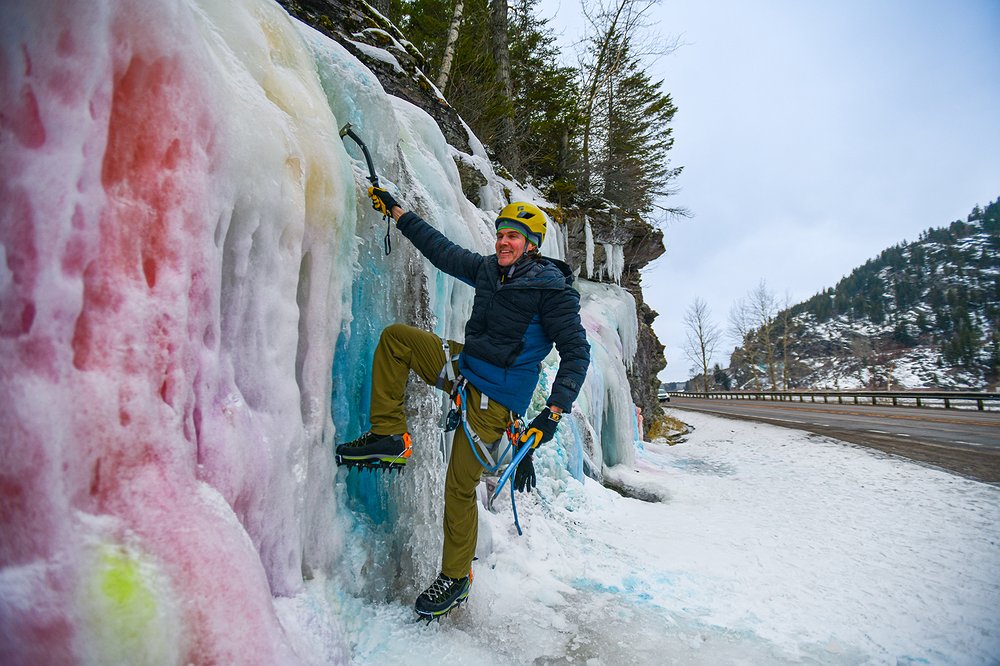Bad Rock Canyon icicle wall becomes frozen canvas
At the darkest times of the year, Bad Rock Canyon lights up with rainbow colors from a large wall of icicles that are ritualistically sprayed with food coloring.
Anyone who drives by would be inclined to ask: Who does this? And why?
The truth of the matter after a lot of asking around is that various people do it because it has been done for a long time, and some other people who do it have no connection to the area. They are taken by spontaneous inspiration.
The stretch of U.S. 2 joining Columbia Falls and Hungry Horse is tight with bends in the road as it winds between the Middle Fork of the Flathead River and the canyon wall.
In the dead of winter, a 40-foot-long wall of decorated icicles is decked out in mysterious flamboyance.
Every year the icicles crop up near the historical marker which describes Bad Rock Canyon as a site of horse theft and bloodshed. A sign for Berne Memorial Roadside Park states that the Montana Highway Department designated this spot as one of the state’s first rest areas in 1956.
Those who live in the canyon towns of Hungry Horse, Martin City, or Coram have various opinions about the colorful display as it ties in with varying levels of history or lore.
Steve Gengler of Martin City remembers coloring the wall of icicles when he was 8 years old in 1970, though he is sure the practice has existed far longer.
“Sure, I dumped shit all over it — or my parents held me up while I did. We were excited to see them every year.”
Gengler recalls years the icicles were decorated so heavily, sometimes with spray paint, that they turned brown, ultimately deciding that as he gets older, he would like to see their natural color again — yet he tempers that expectation with advice to the decorators — “Just please use biodegradable dyes.”
Jess Skare, born in Whitefish and a resident of Martin City, knows plenty of people do it but doesn’t join in herself.
“Watching children enjoy it is so awesome,” she says.
Many people visit annually for a photo of themselves beside the colorful ice.
Most decorators list food coloring as their medium, but methods of delivery are diverse. Some employ buckets, or water bottles with a squirt top; others have used squirt guns or standard pump sprayers.
Dwaine Trull of Martin City knows local high school children, like his niece's friends, are up to it, and has heard some idea that decades ago those icicles naturally appeared with unusual colors due to sediment and organic material buried in the fractured rocks there.
A spring feeds water to the area within Berne Memorial Roadside Park, some of which is channeled through a pipe that locals like to use to fill large truck-bed water tanks. Icicle structures further up the Columbia Mountain Trail are left in their natural state.
Dave Bolt of Coram, a white-bearded lifelong denizen of the canyon, says the icicle decorations “all started with a bunch of drunk people who had nothing to do.”
Others remember icicle artists who have come and gone: “Crazy Suzie used to do them,” John Treat of Martin City recalled of canyon resident Susan Louise Peterson, who died in 2015, “and Lacey,” referring to Lacey Jo Dziuk, who died in 2023 and was featured on a memorial pin at this year’s Cabin Fever Days.
“Both of whom are no longer with us. I feel it’s almost an homage to them,” says Treat.
Newcomers are just as likely to join the ritual, such as Ashton Chapman-Davis and Cat Wooten of Kalispell.
“Neither of us have done this in previous years,” said Chapman-Davis. “But it just lights up this whole area for people.”
Dave Parker of Whitefish, who has explored the canyon for four years, last Saturday used the icicles as a practice zone to teach a friend ice climbing, noting that the frozen falls extend high above those visible from the roadside.
“It’s not so dangerous,” he said with his pickax in hand and crampon spikes on his boots, “as long as you stay away from that road.”
Reporter Carl Foster can be reached at 758-4407 or cfoster@dailyinterlake.com.






















